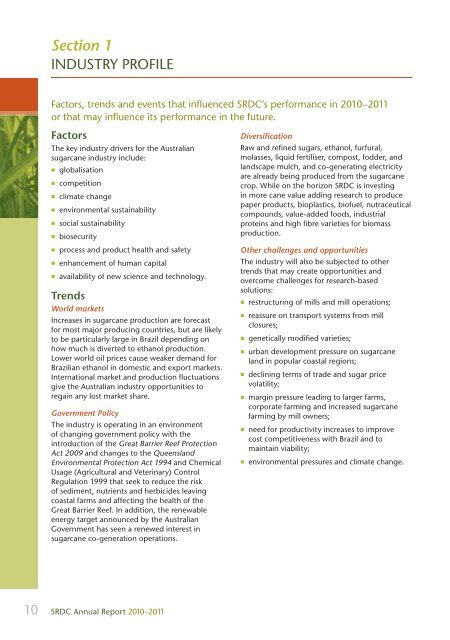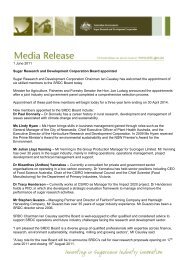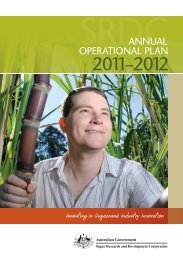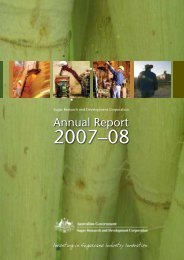Section 2 - Sugar Research and Development Corporation
Section 2 - Sugar Research and Development Corporation
Section 2 - Sugar Research and Development Corporation
You also want an ePaper? Increase the reach of your titles
YUMPU automatically turns print PDFs into web optimized ePapers that Google loves.
10<br />
<strong>Section</strong> 1<br />
INDUSTRY PROFILE<br />
Factors, trends <strong>and</strong> events that infl uenced SRDC’s performance in 2010–2011<br />
or that may infl uence its performance in the future.<br />
Factors<br />
The key industry drivers for the Australian<br />
sugarcane industry include:<br />
��globalisation ��competition ��climate change<br />
��environmental sustainability<br />
��social sustainability<br />
��biosecurity ��process <strong>and</strong> product health <strong>and</strong> safety<br />
��enhancement of human capital<br />
��availability of new science <strong>and</strong> technology.<br />
Trends<br />
World markets<br />
Increases in sugarcane production are forecast<br />
for most major producing countries, but are likely<br />
to be particularly large in Brazil depending on<br />
how much is diverted to ethanol production.<br />
Lower world oil prices cause weaker dem<strong>and</strong> for<br />
Brazilian ethanol in domestic <strong>and</strong> export markets.<br />
International market <strong>and</strong> production fl uctuations<br />
give the Australian industry opportunities to<br />
regain any lost market share.<br />
Government Policy<br />
The industry is operating in an environment<br />
of changing government policy with the<br />
introduction of the Great Barrier Reef Protection<br />
Act 2009 <strong>and</strong> changes to the Queensl<strong>and</strong><br />
Environmental Protection Act 1994 <strong>and</strong> Chemical<br />
Usage (Agricultural <strong>and</strong> Veterinary) Control<br />
Regulation 1999 that seek to reduce the risk<br />
of sediment, nutrients <strong>and</strong> herbicides leaving<br />
coastal farms <strong>and</strong> affecting the health of the<br />
Great Barrier Reef. In addition, the renewable<br />
energy target announced by the Australian<br />
Government has seen a renewed interest in<br />
sugarcane co-generation operations.<br />
SRDC Annual Report 2010–2011<br />
Diversifi cation<br />
Raw <strong>and</strong> refi ned sugars, ethanol, furfural,<br />
molasses, liquid fertiliser, compost, fodder, <strong>and</strong><br />
l<strong>and</strong>scape mulch, <strong>and</strong> co-generating electricity<br />
are already being produced from the sugarcane<br />
crop. While on the horizon SRDC is investing<br />
in more cane value adding research to produce<br />
paper products, bioplastics, biofuel, nutraceutical<br />
compounds, value-added foods, industrial<br />
proteins <strong>and</strong> high fi bre varieties for biomass<br />
production.<br />
Other challenges <strong>and</strong> opportunities<br />
The industry will also be subjected to other<br />
trends that may create opportunities <strong>and</strong><br />
overcome challenges for research-based<br />
solutions:<br />
��restructuring of mills <strong>and</strong> mill operations;<br />
��reassure on transport systems from mill<br />
closures;<br />
��genetically modifi ed varieties;<br />
��urban development pressure on sugarcane<br />
l<strong>and</strong> in popular coastal regions;<br />
��declining terms of trade <strong>and</strong> sugar price<br />
volatility;<br />
��margin pressure leading to larger farms,<br />
corporate farming <strong>and</strong> increased sugarcane<br />
farming by mill owners;<br />
��need for productivity increases to improve<br />
cost competitiveness with Brazil <strong>and</strong> to<br />
maintain viability;<br />
��environmental pressures <strong>and</strong> climate change.






